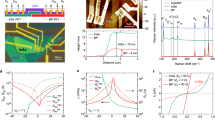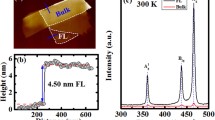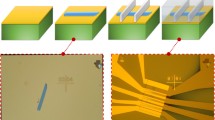Abstract
Introducing heterogeneous architecture is a prospective way to improve tunneling field-effect transistors (TFETs). We investigate the van der Waals (vdW) heterojunction based on monolayer black phosphorene and indium selenide (BP/InSe heterojunction) and the double-gated 10-nm TFETs based on the vdW BP/InSe heterojunction with the contact length and position by using the ab-initio quantum transport simulations. The vdW BP/InSe heterojunction shows a type-II band edge alignment. The optimal vdW BP/InSe heterojunction TFETs have a 1-nm-length BP/InSe heterojunction at the channel’s left and right sites (1L and 1R for short). Novelty, the BP/InSe heterojunction TFETs with 1L and 1R configurations are n- and p-type devices, respectively, and corresponding high on-currents of 240 and 408 μA/μm are obtained for high-performance application (off-current: 0.1 μA/μm) at a very low supply voltage (0.3 V).
Graphical abstract






source to drain tunneling window of Vds = 0.3 V; the isovalue of the transmission eigenstates is 0.05 au

source to drain tunneling window of Vds = 0.3 V
Similar content being viewed by others
References
Ionescu AM, Riel H (2011) Tunnel field-effect transistors as energy-efficient electronic switches. Nature 479:329–337. https://doi.org/10.1038/nature10679
Lv YW, Qin WJ, Wang CL, Liao L, Liu XQ (2019) Recent advances in low-dimensional heterojunction-based tunnel field effect transistors. Adv Electron Mater 5:1800569. https://doi.org/10.1002/aelm.201800569
Seabaugh AC, Zhang Q (2010) Low-voltage tunnel transistors for beyond cmos logic. Proc IEEE 98:2095–2110. https://doi.org/10.1109/JPROC.2010.2070470
Yoon YJ, Seo JH, Cho S, Kwon HI, Lee JH, Kang IM (2016) Sub-10 nm Ge/GaAs heterojunction-based tunneling field-effect transistor with vertical tunneling operation for ultra-low-power applications. J Semicond Tech Sci 16:172–178. https://doi.org/10.5573/jsts.2016.16.2.172
Lattanzio L, De Michielis L, Ionescu AM (2012) Complementary germanium electron-hole bilayer tunnel fet for sub-0.5-v operation. IEEE Electron Dev Lett 33:167–169. https://doi.org/10.1109/led.2011.2175898
Padilla JL, Medina-Bailon CM, Marquez C, Sampedro C, Donetti L, Gamiz F, Ionescu AM (2018) Gate leakage tunneling impact on the inas/gasb heterojunction electron-hole bilayer tunneling field-effect transistor. IEEE Tran Electron Dev 65:4679–4686. https://doi.org/10.1109/ted.2018.2866123
Shih C, Chien ND (2011) Sub-10-nm tunnel field-effect transistor with graded si/ge heterojunction. IEEE Electron Dev Lett 32:1498–1500. https://doi.org/10.1109/LED.2011.2164512
Toh E-H, Wang GH, Chan L, Samudra G, Yeo Y-C (2007) Device physics and guiding principles for the design of double-gate tunneling field effect transistor with silicon-germanium source heterojunction. Appl Phys Lett 91:243505. https://doi.org/10.1063/1.2823606
Roy T, Tosun M, Cao X, Fang H, Lien D-H, Zhao P, Chen Y-Z, Chueh Y-L, Guo J, Javey A (2015) Dual-gated mos2/wse2 van der waals tunnel diodes and transistors. ACS Nano 9:2071–2079. https://doi.org/10.1021/nn507278b
Roy T, Tosun M, Hettick M, Ahn GH, Hu C, Javey A (2016) 2D–2D tunneling field-effect transistors using WSe2/SnSe2 heterostructures. Appl Phys Lett 108:083111. https://doi.org/10.1063/1.4942647
Jiang XW, Luo JW, Li SS, Wang LW (2015) How good is mono-layer transition-metal dichalcogenide tunnel field-effect transistors in sub-10 nm? An ab initio simulation study. In: Proceedings of 2015 IEEE international electron devices meeting (IEDM) Washington, DC, USA
Yan X, Liu CS, Li C, Bao WZ, Ding SJ, Zhang DW, Zhou P (2017) Tunable SnSe2/WSe2 heterostructure tunneling field effect transistor. Small 13:1701478. https://doi.org/10.1002/smll.201701478
Sarkar D, Xie XJ, Liu W, Cao W, Kang JH, Gong YJ, Kraemer S, Ajayan PM, Banerjee K (2015) A subthermionic tunnel field-effect transistor with an atomically thin channel. Nature 526:91–95. https://doi.org/10.1038/nature15387
Szabo A, Koester SJ, Luisier M (2015) Ab-initio simulation of van der waals mote2-sns2 heterotunneling fets for low-power electronics. IEEE Electron Dev Lett 36:514–516. https://doi.org/10.1109/led.2015.2409212
Li M, Esseni D, Nahas JJ, Jena D, Xing HG (2015) Two-dimensional heterojunction interlayer tunneling field effect transistors (thin-tfets). IEEE J Electron Dev Soc 3:206–213. https://doi.org/10.1109/jeds.2015.2390643
Li H, Lu J (2019) Sub-10 nm vertical tunneling transistors based on layered black phosphorene homojunction. Appl Surf Sci 465:895–901
Li H, Shi B, Pan Y, Li J, Xu L, Zhang X, Pan F, Lu J (2018) Sub-5 nm monolayer black phosphorene tunneling transistors. Nanotechnology 29:485202
Li H, Tie J, Li J, Ye M, Zhang H, Zhang X, Pan Y, Wang Y, Quhe R, Pan F, Lu J (2018) High-performance sub-10-nm monolayer black phosphorene tunneling transistors. Nano Res 11:2658–2668. https://doi.org/10.1007/s12274-017-1895-6
Liu F, Wang J, Guo H (2016) Impact of edge states on device performance of phosphorene heterojunction tunneling field effect transistors. Nanoscale 8:18180–18186. https://doi.org/10.1039/c6nr05734a
Kim S, Myeong G, Park J, Watanabe K, Taniguchi T, Cho S (2020) Monolayer hexagonal boron nitride tunnel barrier contact for low-power black phosphorus heterojunction tunnel field-effect transistors. Nano Lett 20:3963–3969. https://doi.org/10.1021/acs.nanolett.0c01115
Kim S, Myeong G, Shin W, Lim H, Kim B, Jin T, Chang S, Watanabe K, Taniguchi T, Cho S (2020) Thickness-controlled black phosphorus tunnel field-effect transistor for low-power switches. Nat Nanotechnol 15:203–206. https://doi.org/10.1038/s41565-019-0623-7
Wu P, Ameen T, Zhang HR, Bendersky LA, Ilatikhameneh H, Klimeck G, Rahman R, Davydov AV, Appenzeller J (2019) Complementary black phosphorus tunneling field-effect transistors. ACS Nano 13:377–385. https://doi.org/10.1021/acsnano.8b06441
Li H, Xu PP, Xu L, Zhang ZY, Lu J (2019) Negative capacitance tunneling field effect transistors based on monolayer arsenene, antimonene, and bismuthene. Semicond Sci Technol 34:085006. https://doi.org/10.1088/1361-6641/ab2cd8
Chang J (2018) Novel antimonene tunneling field-effect transistors using an abrupt transition from semiconductor to metal in monolayer and multilayer antimonene heterostructures. Nanoscale 10:13652–13660. https://doi.org/10.1039/c8nr03191f
Li H, Xu PP, Lu J (2019) Sub-10 nm tunneling field-effect transistors based on monolayer group IV mono-chalcogenides. Nanoscale 11:23392–23401. https://doi.org/10.1039/c9nr07590a
Xu PP, Liang JK, Li H, Liu FB, Tie J, Jiao ZW, Luo J, Lu J (2020) Device performance limits and negative capacitance of monolayer GeSe and GeTe tunneling field effect transistors. RSC Adv 10:16071–16078. https://doi.org/10.1039/d0ra02265a
Li H, Liang JK, Xu PP, Luo J, Liu FB (2020) Vertically stacked SnSe homojunctions and negative capacitance for fast low-power tunneling transistors. RSC Adv 10:20801–20808. https://doi.org/10.1039/d0ra03279d
Wang W, Sun Y, Wang H, Xu HS, Xu M, Jiang ST, Yue GS (2016) Investigation of light doping and hetero gate dielectric carbon nanotube tunneling field-effect transistor for improved device and circuit-level performance. Semicond Sci Tech 31:035002. https://doi.org/10.1088/0268-1242/31/3/035002
Tahaei SH, Ghoreishi SS, Yousefi R, Aderang H (2019) A computational study of a heterostructure tunneling carbon nanotube field-effect transistor. J Electron Mater 48:7048–7054. https://doi.org/10.1007/s11664-019-07513-y
Tamersit K (2020) Computational study of p-n carbon nanotube tunnel field-effect transistor. IEEE Trans Electron Dev 67:704–710. https://doi.org/10.1109/ted.2019.2957050
Lu SC, Zhu MM, WJ, (2016) Novel vertical hetero- and homo-junction tunnel field-effect transistors based on multi-layer 2D crystals. 2D Mater 3:011010. https://doi.org/10.1088/2053-1583/3/1/011010
Nasir SNFM, Ullah H, Ebadi M, Tahir AA, Sagu JS, Mat Teridi MA (2017) New insights into se/bivo4 heterostructure for photoelectrochemical water splitting: a combined experimental and dft study. J Phys Chem C 121:6218–6228. https://doi.org/10.1021/acs.jpcc.7b01149
Wei Y, Wang F, Zhang W, Zhang X (2019) The electric field modulation of electronic properties in a type-II phosphorene/PbI2 van der Waals heterojunction. Phys Chem Chem Phys 21:7765–7772. https://doi.org/10.1039/C9CP00733D
El Mouhi R, El Khattabi S, Hachi M, Fitri A, Benjelloun AT, Benzakour M, McHarfi M, Bouachrine M (2019) DFT and TD-DFT calculations on thieno[2,3-b]indole-based compounds for application in organic bulk heterojunction (BHJ) solar cells. Res Chem Intermediat 45:1327–1340. https://doi.org/10.1007/s11164-018-3674-8
Lacerda LHdS, de Lazaro SR (2017) Isomorphic substitution and intermediary energy levels: A new application of DFT modelling and semiconductor theory to describe p–n type junctions interface in heterostructures. Phys Status Solidi B 254:1700119. https://doi.org/10.1002/pssb.20170011
Zhao X, Bo M, Huang Z, Zhou J, Peng C, Li L (2018) Heterojunction bond relaxation and electronic reconfiguration of WS2- and MoS2-based 2D materials using BOLS and DFT. Appl Surf Sci 462:508–516. https://doi.org/10.1016/j.apsusc.2018.08.139
Li L, Yu Y, Ye GJ, Ge Q, Ou X, Wu H, Feng D, Chen XH, Zhang Y (2014) Black phosphorus field-effect transistors. Nat Nanotechnol 9:372–377. https://doi.org/10.1038/nnano.2014.35
Qiao J, Kong X, Hu Z-X, Yang F, Ji W (2014) High-mobility transport anisotropy and linear dichroism in few-layer black phosphorus. Nat Commun 5:4475. https://doi.org/10.1038/ncomms5475
Mudd GW, Svatek SA, Ren T, Patane A, Makarovsky O, Eaves L, Beton PH, Kovalyuk ZD, Lashkarev GV, Kudrynskyi ZR, Dmitriev AI (2013) Tuning the bandgap of exfoliated inse nanosheets by quantum confinement. Adv Mater 25:5714–5718. https://doi.org/10.1002/adma.201302616
Bandurin DA, Tyurnina AV, Yu GL, Mishchenko A, Zolyomi V, Morozov SV, Kumar RK, Gorbachev RV, Kudrynskyi ZR, Pezzini S, Kovalyuk ZD, Zeitler U, Novoselov KS, Patane A, Eaves L, Grigorieva IV, Fal’ko VI, Geim AK, Cao Y (2017) High electron mobility, quantum Hall effect and anomalous optical response in atomically thin InSe. Nat Nanotechnol 12:223–227. https://doi.org/10.1038/nnano.2016.242
QuantumATK, version P-2019.03. https://www.synopsys.com/silicon/quantumatk.html
Smidstrup S, Markussen T, Vancraeyveld P, Wellendorff J, Schneider J, Gunst T, Verstichel B, Stradi D, Khomyakov PA, Vej-Hansen UG, Lee ME, Chill ST, Rasmussen F, Penazzi G, Corsetti F, Ojanpera A, Jensen K, Palsgaard MLN, Martinez U, Blom A, Brandbyge M, Stokbro K (2020) QuantumATK: an integrated platform of electronic and atomic-scale modelling tools. J Phys Condens Mater 32:015901. https://doi.org/10.1088/1361-648X/ab4007
Perdew JP, Burke K, Ernzerhof M (1996) Generalized gradient approximation made simple. Phys Rev Lett 78:3865
Monkhorst HJ (1976) Special points for Brillouin-zone integrations. Phys Rev B 13:5188–5192
Liang Y, Yang L (2015) Carrier plasmon induced nonlinear band gap renormalization in two-dimensional semiconductors. Phys Rev Lett 114:063001. https://doi.org/10.1103/PhysRevLett.114.063001
Gao S, Yang L (2017) Renormalization of the quasiparticle band gap in doped two-dimensional materials from many-body calculations. Phys Rev B 96:155410
Zhang Y, Chang T-R, Zhou B, Cui Y-T, Yan H, Liu Z, Schmitt F, Lee J, Moore R, Chen Y, Lin H, Jeng H-T, Mo S-K, Hussain Z, Bansil A, Shen Z-X (2013) Direct observation of the transition from indirect to direct bandgap in atomically thin epitaxial MoSe2. Nat Nanotechnol 9:111. https://doi.org/10.1038/nnano.2013.277
Quhe R, Qiu L, Zhang Q, Wang Y, Han Z, Jing L, Dong C, Kai L, Yu Y, Lun D, Feng P, Ming L, Jing L (2018) Simulations of quantum transport in sub-5-nm monolayer phosphorene transistors. Phys Rev Appl 10:024022
Desai SB, Madhvapathy SR, Sachid AB, Llinas JP, Wang Q, Ahn GH, Pitner G, Kim MJ, Bokor J, Hu C (2016) MoS2 transistors with 1-nanometer gate lengths. Science 354:99
Pan Y, Yang D, Wang Y, Meng Y, Han Z, Quhe R, Zhang X, Li J, Guo W, Li Y (2017) Schottky barriers in bilayer phosphorene transistors, acs appl. Mater Inter 9:12694–12705
Pan Y, Wang Y, Ye M, Quhe R, Zhong H, Song Z, Peng X, Yu D, Yang J, Shi J (2016) Monolayer phosphorene-metal contacts. Chem Mater 28:2100–2109
Zhang X, Pan Y, Ye M, Quhe R, Wang Y, Guo Y, Zhang H, Dan Y, Song Z, Li J, Yang J, Guo W, Lu J (2017) Three-layer phosphorene-metal interfaces. Nano Res 11:707–721
Gao A, Lai J, Wang Y, Zhu Z, Zeng J, Yu G, Wang N, Chen W, Cao T, Hu W, Sun D, Chen X, Miao F, Shi Y, Wang X (2019) Observation of ballistic avalanche phenomena in nanoscale vertical InSe/BP heterostructures. Nat Nanotechnol 14:217–222. https://doi.org/10.1038/s41565-018-0348-z
Allec SI, Wong BM (2016) Inconsistencies in the electronic properties of phosphorene nanotubes: new insights from large-scale dft calculations. J Phys Chem Lett 7:4340–4345. https://doi.org/10.1021/acs.jpclett.6b02271
Datta S (1995) Electronic transport in mesoscopic systems. Cambridge University Press, Cambridge
Ding YM, Shi JJ, Xia CX, Zhang M, Du J, Huang P, Wu M, Wang H, Cen YL, Pan SH (2017) Enhancement of hole mobility in InSe monolayer via an InSe and black phosphorus heterostructure. Nanoscale 9:14682–14689. https://doi.org/10.1039/c7nr02725g
Lv QS, Yan FG, Mori N, Zhu WK, Hu C, Kudrynskyi ZR, Kovalyuk ZD, Patane A, Wang KY (2020) Interlayer band-to-band tunneling and negative differential resistance in van der waals BP/InSe field-effect transistors. Adv Funct Mater 30:1910713. https://doi.org/10.1002/adfm.201910713
Acknowledgement
This work was supported by the National Natural Science Foundation of China (Nos. 11704008 and 91964101), Beijing Natural Science Foundation of China (No. 4212046), the Support Plan of Yuyou Youth, Yuyou Innovation Team, and the fund of high-level characteristic research direction from North China University of Technology.
Author information
Authors and Affiliations
Corresponding authors
Additional information
Handling Editor: Kevin Jones.
Publisher's Note
Springer Nature remains neutral with regard to jurisdictional claims in published maps and institutional affiliations.
Supplementary Information
Rights and permissions
About this article
Cite this article
Li, H., Wang, Q., Xu, P. et al. Van der waals BP/InSe heterojunction for tunneling field-effect transistors. J Mater Sci 56, 8563–8574 (2021). https://doi.org/10.1007/s10853-021-05784-7
Received:
Accepted:
Published:
Issue Date:
DOI: https://doi.org/10.1007/s10853-021-05784-7




